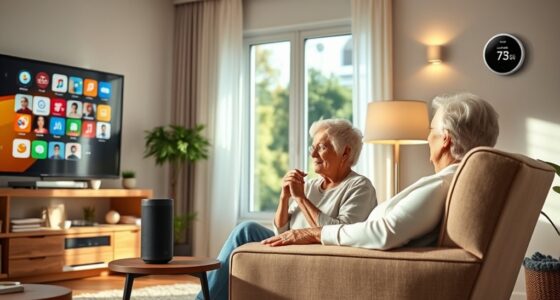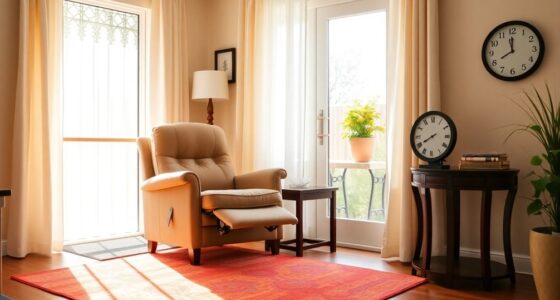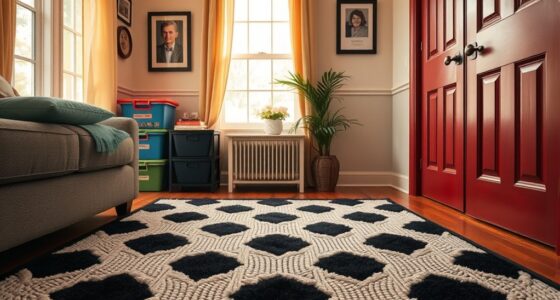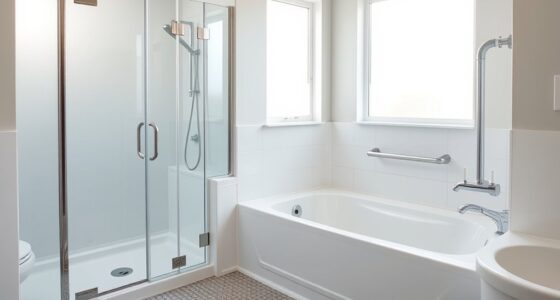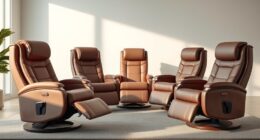To create an accessible home office for your encore career, you should evaluate your workspace for ease of access, ensuring essential tools are within reach and pathways are clear. Use ergonomic furniture that supports good posture, and maximize natural and adjustable lighting for visual comfort. Position your technology at eye level and customize settings to suit your needs. Continually assess your environment to stay safe, comfortable, and productive—as you explore further, you’ll discover more tips to optimize your workspace.
Key Takeaways
- Design workspace with adjustable furniture and sufficient space to accommodate mobility or ergonomic needs.
- Ensure all essential tools and technology are within easy reach to promote independence and efficiency.
- Optimize lighting for visual comfort, including natural light and glare-free, adjustable fixtures.
- Use ergonomic accessories like supportive chairs and monitor stands to prevent strain and injury.
- Maintain a safe, clutter-free environment, reducing trip hazards and ensuring accessibility for diverse abilities.
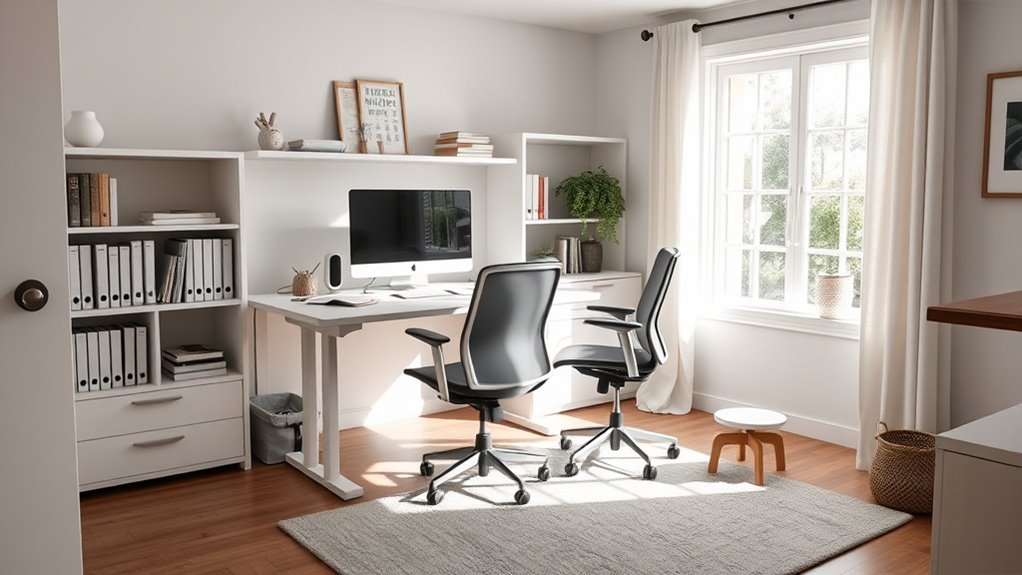
Have you ever considered how accessible your home office truly is? If you’re thinking about an encore career or simply working from home, accessibility plays a pivotal role in your productivity and comfort. The first step is to evaluate your current setup. Is your workspace designed with ease of access in mind? Are your essential tools within arm’s reach, and is there enough space to move comfortably? These questions matter because an accessible home office isn’t just about convenience; it’s essential for your health, efficiency, and overall well-being.
Start by examining your furniture. Do your desk and chair support good posture and allow you to sit comfortably for extended periods? An adjustable chair with lumbar support can prevent back pain, while a spacious desk prevents clutter and restricts movement. If you have mobility challenges or health concerns, consider ergonomic options that reduce strain. Clear pathways are equally important—eliminate trip hazards like loose cords or clutter that could cause falls. Your environment should promote safety and ease of movement.
Lighting is another critical aspect. Ensure your workspace is well-lit to reduce eye strain and fatigue. Natural light is ideal, but if that’s limited, supplement with adjustable, glare-free lighting. Proper illumination helps you stay alert and focused, especially when working on detailed tasks. Additionally, think about your technology setup. Is your computer monitor at eye level? Are your keyboard and mouse positioned to prevent wrist strain? Accessibility extends to your digital tools as well; customizing font sizes, contrast, and using voice commands can make a significant difference if you have visual or dexterity issues.
Think about your environment beyond ergonomics, too. Is your home office situated in a quiet area that minimizes distractions? If noise is an issue, consider soundproofing options or noise-canceling headphones. Temperature control is also essential; a comfortable climate keeps you alert and reduces discomfort that can interfere with concentration. Remember, accessibility isn’t a one-time fix; it’s an ongoing process. Regularly assess your workspace and make adjustments as needed to accommodate changing needs or new challenges.
Ultimately, creating an accessible home office is about designing a space that supports your work, health, and longevity in your encore career. It’s an investment in your well-being and productivity, ensuring you can work comfortably and efficiently no matter your age or physical condition. When your environment is tailored for ease and safety, you’re more likely to stay motivated, engaged, and successful in your professional pursuits. Incorporating legal guidelines related to accessibility can help ensure your workspace meets safety standards and best practices.
Frequently Asked Questions
How Can I Assess My Home Office’s Accessibility Needs?
You can assess your home office’s accessibility needs by evaluating your daily tasks and identifying any challenges you face. Check if your workspace allows easy movement, determine if you need ergonomic furniture, and consider assistive devices like voice recognition or adjustable desks. Ask yourself if lighting and noise levels support focus. You might also consult an occupational therapist for personalized recommendations, ensuring your workspace suits your specific needs and promotes comfort.
What Budget Options Are Available for Home Office Modifications?
You can explore several budget-friendly options for home office modifications. Start with DIY solutions like adjustable desks or foam padding for better comfort. Look into government grants or local programs that offer financial assistance for accessibility upgrades. Consider purchasing secondhand or discounted equipment online. Prioritize essential modifications first, such as ergonomic chairs or ramps, to maximize your budget. Reach out to community resources for additional support and advice.
Are There Government Grants for Home Office Accessibility Improvements?
Yes, there are government grants available for home office accessibility improvements. You can explore programs like the ADA grants or local government initiatives designed to support accessibility upgrades. These grants often cover modifications such as ramps, widened doorways, or adapted workspaces. To find eligibility requirements and application details, visit your local government or disability support agency’s website. Applying for these grants can help you create a more accessible and comfortable home office environment.
How Can I Ensure My Home Office Complies With ADA Standards?
To guarantee your home office complies with ADA standards, start by evaluating your space for accessibility. Install ramps or widened doorways if needed, ensure your workspace is free of obstacles, and use adjustable furniture. Make sure light switches, outlets, and controls are within reach. Keep pathways clear, and consider adding visual or auditory aids. Regularly review ADA guidelines and consult accessibility experts to maintain compliance and create an inclusive environment.
What Are the Best Ergonomic Tools for Accessible Home Offices?
Looking for ergonomic tools to make your home office accessible? Start with an adjustable desk, so you can sit or stand comfortably. Invest in an ergonomic keyboard and mouse to reduce strain, and use a supportive chair with proper lumbar support. A monitor stand helps keep your screen at eye level. These tools make it easier to work comfortably and prevent aches, helping you stay productive and pain-free.
Conclusion
Creating an accessible home office transforms your space into a welcoming garden where every flower, no matter the height or size, can flourish. With thoughtful modifications, you’ll nurture your encore career like a gentle gardener tending to each bloom. As your workspace blossoms with comfort and ease, you’ll find your productivity and confidence grow stronger every day. Embrace these changes, and watch your new chapter unfold like a sunrise—bright, promising, and full of potential.


